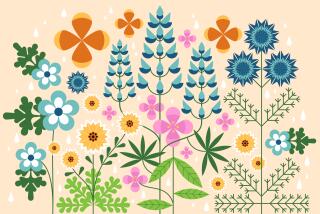Gardening : Now Is the Time to Get That Head Start on Bulb Planting
- Share via
Bulbs are the first thing that comes to mind in the fall, though not necessarily the first thing to go in the ground.
The two most popular--tulips and daffodils--are best planted a little later in the season, though you could drive down to the nursery and buy them this morning while there is still a good selection. Put the tulips in the refrigerator when you get home and keep them there until after Thanksgiving; daffodils should also be kept cool until they are planted, though they
can go in the ground later this month.
While you are at the nursery, see if you can find any bulbs native to the Cape region of South Africa. (Though native to South Africa, what you are actually buying are hybrids developed by the Dutch.) These should be planted right away. Planting a few is
the perfect weekend project--no elaborate soil preparation is required and you don’t need to dig any big holes.
What are they? Freesias are the best known, but South Africa is rich with native bulbs and almost all of them thrive in California’s similar Mediterranean climate.
You don’t have to dig any big holes because these are not big bulbs. (Actually, very few are technically bulbs, they are “corms,” though this doesn’t change how they are planted.) If you have visions of a Dutch flower field in mind, you will be disappointed. But if you think of wildflowers, you will find these small bulbs delightful.
Tuck them here and there. Wherever you can find a vacant square foot or so is a likely home--next to or in the gaps between paving stones, at the foot of steps, by the back door, clustered at the base of a fence post or gate, or in pots (they are perfectly adapted to container culture).
My method of spotting them throughout the garden is not very scientific, but pleasant enough. With a coffee cup in one hand and bags of bulbs in the other, I stroll through the garden looking for likely places and simply leave a bag of bulbs there to mark the spot. Later I come back and plant them. I don’t even mark where I planted them since I like being surprised in the spring.
South African bulbs should always be planted in clumps of at least a half-dozen, and don’t space them out like bedding plants or bigger bulbs. Space them only a few inches apart. Here’s my method of planting: I load up an old dishpan with soil amendment (something like Gromulch or Bandini Soil Builder 102), toss the trowel in on top, and set a bag of granular fertilizer (any ordinary, all-purpose kind will do) in one corner. I carry this from planting site to planting site.
To plant, I dig a hole about a foot across and six inches deep, tossing the soil into the dish pan. I sprinkle a little granular fertilizer in the bottom of the hole (about a tablespoon should do it) then mix the soil with some of the soil amendment in the dish pan and fill the hole back up. South African bulbs shouldn’t be planted more than a
few inches deep so I simply push them into the loose soil, cover them and tamp the soil back into the hole so it isn’t loose. Then on to the next bag of bulbs. What could be easier?
Freesias are the easiest South African bulb to find at nurseries, but be forewarned that, when in flower, they have a ten
dency to fall flat on their pretty faces. To keep them upright, try planting them between other shorter plants. Freesias grow about a foot tall. In fact, height is one way of organizing the many kinds of South African bulbs.
Also falling into the foot-tall category are babianas, lachenalia, sparaxis, streptanthera and tritonia. Lost already? There are dozens more and almost none have common names so you’re going to have to learn to handle these monikers. It might help to write down a shopping list to take to the nursery; all of the above should be listed under “foot-tall: plant 2 inches apart in clusters of six.”
Babianas do have the seldom-used common name of baboon flower (baboons are said to relish them) and the flowers are mostly purplish-blue or white. Lachenalias--with flowers like gaily colored fireworks--look far too exotic to be so easy, but they are. Sparaxis are sometimes called harlequin flowers and are as colorful and mixed-up as a clown suit. Streptanthera comes in some soft, sherbety shades of orange and pink, and tritonias are brighter versions of the same colors.
Under the “two to three foot-tall: plant 3 inches apart in clusters of six” category should be homeria and ixias, the former with soft orange flowers and the latter with flowers that could be yellow or orange but are more likely magenta or white.
Most of these South African bulbs bloom early in the year, as soon as January, one reason to plant them right away. When their foliage dries up after flowering simply cut it off and leave the bulbs in the ground. They’ll return year after year.






